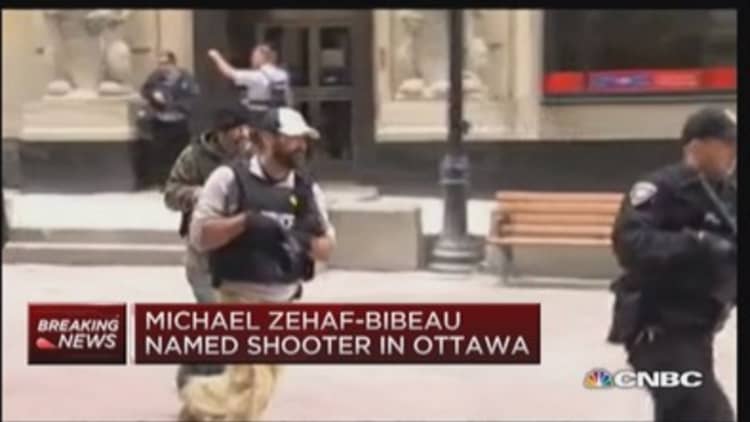
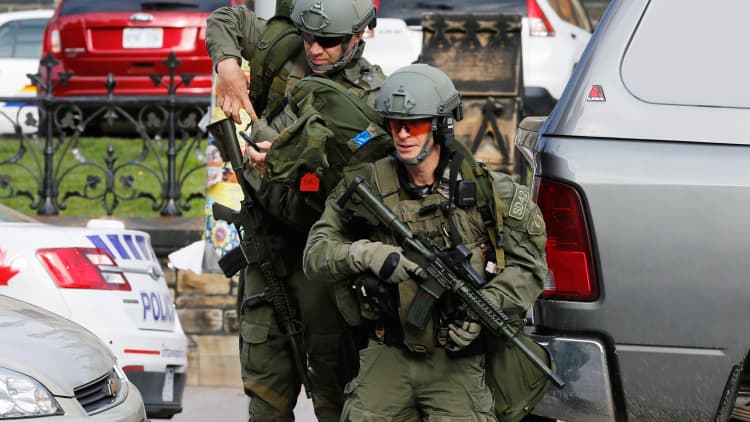
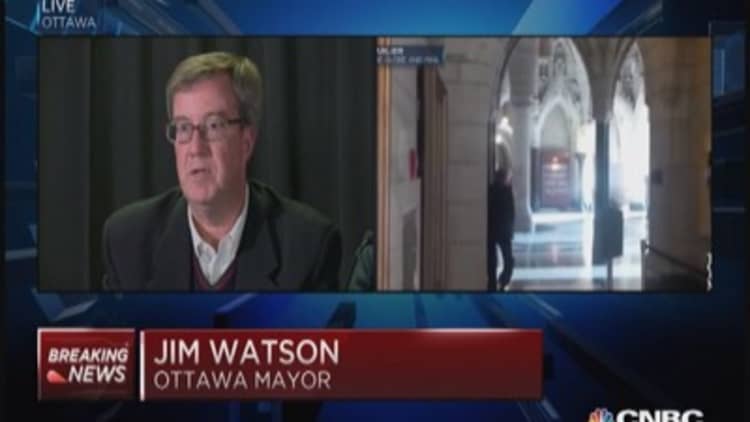
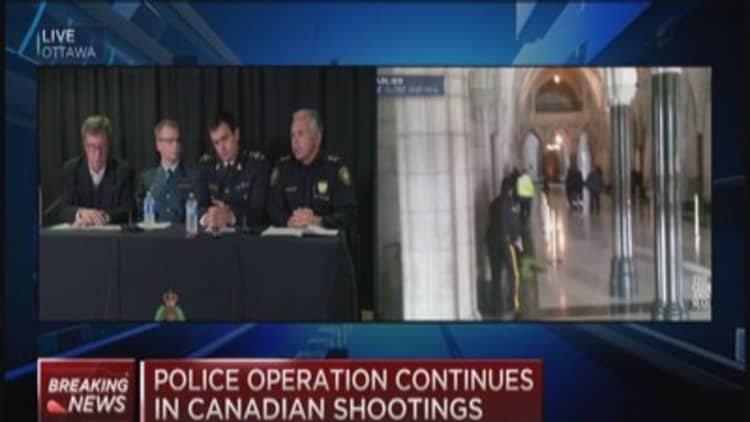
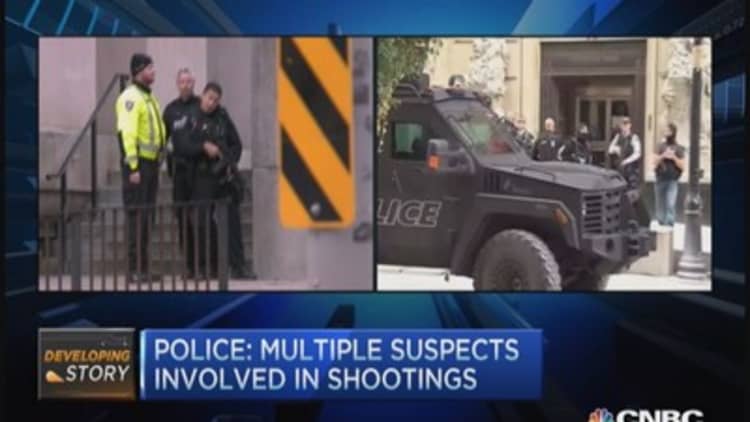
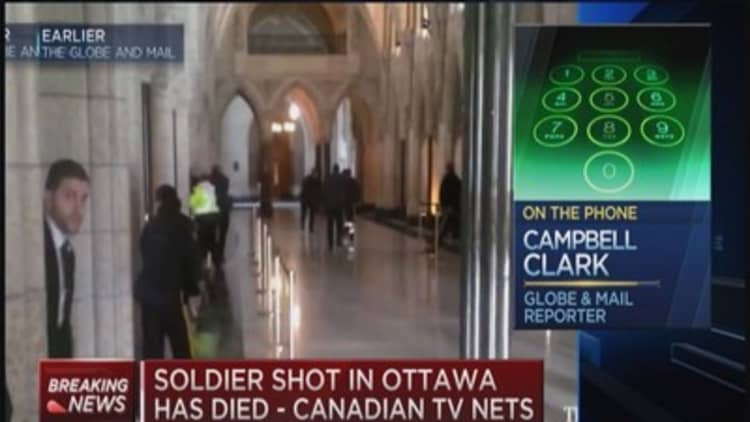
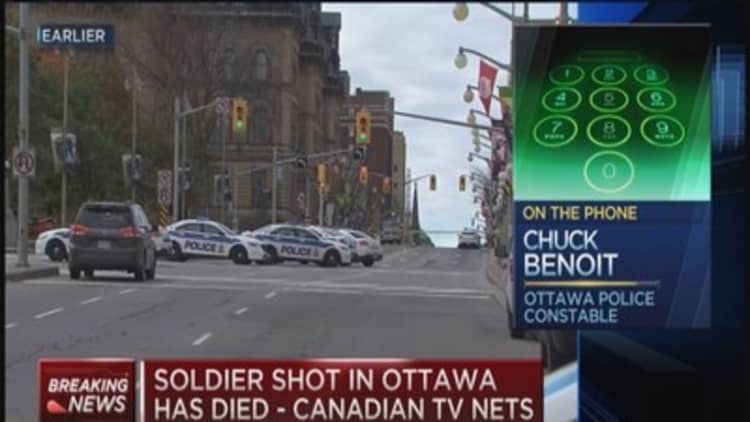
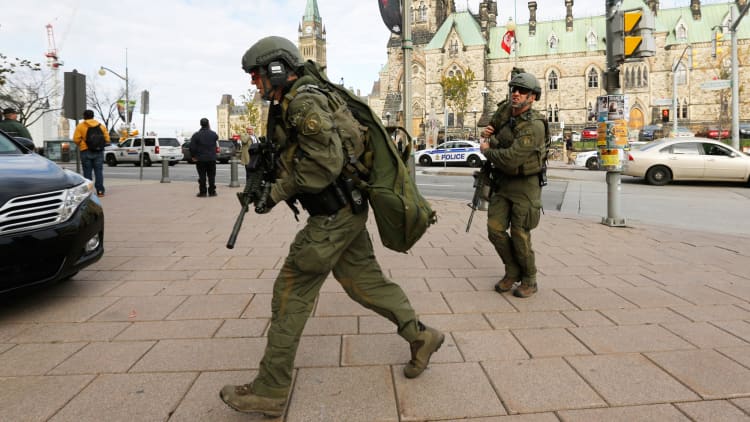
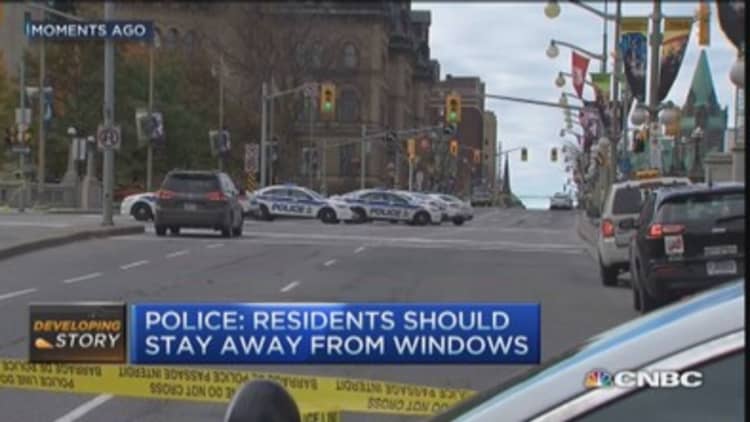
A Canadian soldier guarding the National War Memorial in Ottawa was shot and killed Wednesday, and a burst of gunfire minutes later terrorized Parliament and sent lawmakers scrambling for safety.
Sources identified the gunman to NBC News as Michael Joseph Hall, 32, a convert to Islam who was using the name Michael Zehaf-Bibeau. He was confirmed dead. Canadian media, quoting an aunt, identified the victim as Cpl. Nathan Cirillo of Hamilton, Ontario, a member of the Argyll and Sutherland Highlanders, one of Canada's largest reserve units.
More from NBC News:
Operation Moonlight: Diversion was 'serious lapse' for Secret Service
Autopsy suggests Michael Brown reached for Ferguson officer's gun
Wreck of Nazi U-Boat 576, U.S. freighter found off North Carolina
Few details of either man were immediately available, and confusion continued to grip Canada's capital for hours after the attack began. Police couldn't say whether the same person opened fire in both places, whether anyone was still on the loose or what the motive might have been.
Prime Minister Stephen Harper, who was on Parliament Hill when the first shots were fired, was whisked to safety. Members of the legislature barricaded themselves in their offices and piled chairs high against doors for safety.
"This is a dynamic and unfolding situation," said Gilles Michaud, a commander with the Royal Canadian Mounted Police.
Read More
Ottawa Hospital said it had three patients, all of them with minor injuries.
The attack came at a time of heightened concern about terrorism in Canada. On Monday, a man described as a radical Islamic convert ran down two Canadian soldiers with his car, killing one of them.
NBC News reported this week that Canadian officials have been concerned about the potential for knife and gun attacks, including strikes against military personnel, because of the nation's involvement in international fight against ISIS.
The attack paralyzed the center of the Canadian government after the first shots were fired just before 10 a.m. ET. For hours, there was confusion about the number of shooters. Ottawa police Constable Marc Soucy told MSNBC at midafternoon: "We're not sure how many suspects there are. We're still actively looking."
There were also reports of shots fired at a nearby mall, the Rideau Centre, but police said nothing had happened there.
Cirillo was standing guard across the street from Parliament at the War Memorial, a tall granite cenotaph adorned with bronze figures representing Canadians who fought in World War I.
Inside Parliament, which was in session, a volley of gunfire could be heard for about 10 seconds in a video posted online by the Canadian newspaper The Globe and Mail. Sen. George Baker, a member of Parliament, told MSNBC from his office, where he was holed up, that about 50 shots had been fired.
"I heard this pop, pop, pop and thought it was dynamite for construction rather than something else," John McKay, another lawmaker, told CTV.
Another member of Parliament, Michelle Rempel, posted on Twitter: "Mom I'm okay, I'm hiding." Justin Ling, a freelance journalist who was barricaded inside a cafeteria, told MSNBC that officers had told him: "There's an active shooter. Get inside. Get inside."
Soucy, of the Ottawa police, told MSNBC that witness descriptions of the shooter or shooters ranged from people "wearing a scarf around their head to dressed in all black, so we're looking at everyone."
The Royal Canadian Mounted Police urged people in downtown Ottawa to stay away from windows and roofs. Baker, the member of Parliament, said that he could see about 100 armed officers circling the building.
Police and military officials clarified little at an afternoon news conference. They asked people to stay away from the center of downtown and be vigilant, but they couldn't say whether a suspect remained at large. They also couldn't say what kind of gun was used.
"We all want answers, none more so than me," Mayor Jim Watson said.
To the soldier's family, he said: "There's no pain greater than losing a loved one. To have it happen in such circumstances as this morning is beyond expression, and underlined by a sad anger within my heart."
Harper was expected to speak later in the day. "Our thoughts and prayers are with the families of those who were attacked," his office said in a statement.
Video courtesy of Globe & Mail.
The shooting came days after Canada raised its domestic terrorism threat level. The Royal Canadian Mounted Police said it was watching at least 90 known ISIS sympathizers. And the FBI has been working closely with Canadian authorities as both countries watch for threats against their citizens.
"This is exactly, again, what intelligence officials have been worried about," said Michael Leiter, former director of the U.S. National Counterterrorism Center and an NBC News analyst.
In the car attack Monday, authorities identified the attacker to NBC News as Martin Rouleau, 25, a radical Muslim who may have acted alone but had links to other suspected fundamentalists. One soldier died, and the other was injured. The suspect was shot by police and later died.
Authorities were monitoring him and had revoked his passport before the attack.
In the attack Wednesday, an Instagram user, Amer Adas, posted video of paramedics loading someone into an ambulance and of police with weapons drawn:
A U.S. Department of Homeland Security official told NBC News that there was "no specific reporting" to indicate a threat to the U.S., the attack reverberated there, as well. The U.S. Embassy in Ottawa was locked down, and The Tomb of the Unknowns at Arlington National Cemetery in the Virginia suburbs of Washington increased security. NORAD, the joint U.S.-Canadian air command, went on high alert. New York police said they would assign "special attention" to certain locations.
President Barack Obama, who spoke by phone with Harper, told reporters Wednesday afternoon that while it was too early to know what motivated the shootings, he had assigned his national security team to work closely with Canadian authorities because the long U.S.-Canadian border could "factor in to ongoing efforts to counter terror attacks in our country."
In Toronto, the largest city in Canada, police said they knew of no specific threat, but they ordered stepped-up patrols at City Hall, courthouses and other government facilities and on the subway.
Two events honoring the Pakistani teenager and recent Nobel Peace Prize winner Malala Yousafzai, who was shot in the head by the Taliban two years ago for promoting education for girls, were canceled. At one, she was to have received honorary Canadian citizenship.
The National Hockey League postponed a game scheduled for Wednesday night between the Ottawa Senators and the Toronto Maple Leafs.
Canada has some history with violence and terrorism. In the 1960s and the early 1970s, Quebec separatists formed an armed resistance group that killed a British diplomat and kidnapped and killed a minister of the Quebec government.
In 1984, a Canadian soldier barged into the legislature of Quebec, shot several lawmakers and sat down in the speaker's chair, where he remained, on television, for hours. The crisis was managed to an end by the sergeant-at-arms, who shared cigarettes with the gunman and talked him down.
And in 1989, in what was known as the Montreal Massacre, a 25-year-old man entered the Ecole Polytechnique and shot 28 people, killing 14 of tem, before killing himself. As he entered a classroom, he separated the men from the women and shot all nine women in the room.
This story is developing. Please check back for further updates.
Kristin Donnelly, Alastair Jamieson, M. Alex Johnson, Mark Lukasiewicz, Kristen Welker and Pete Williams of NBC News contributed to this report.

